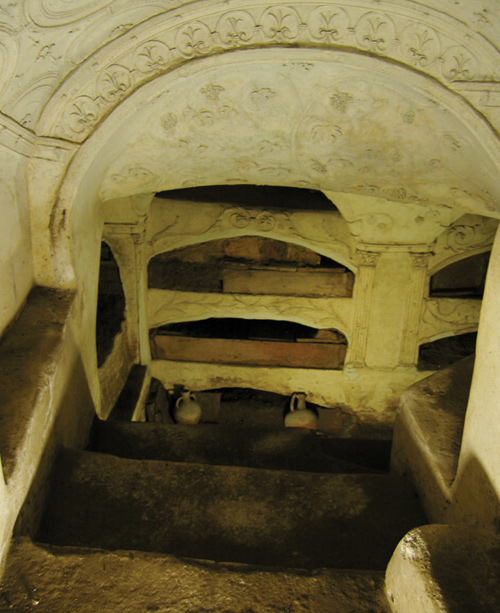San Clemente The many layers of this fascinating church reveal the changing ideals of Rome in various eras .

Ceiling, San Clemente

Underground font, San Clemente
Catacombs The
burial tunnels of Rome’s early Christians are like a honeycomb beneath
the consular roads out of Rome, especially along Via Appia Antica.
Grave niches stacked like shelving along dark corridors are carved into
the tufa, with some precious remnants of fresco and engraved marble
slabs .

Vatican Grottoes The famous Red Wall behind which Peter was supposedly buried was discovered under the Vatican in the 1940s . Nero’s Golden House Like
most of “underground Rome”, Nero’s fabulous and vast palace was not
originally buried. But when Renaissance worthies such as Raphael chopped
holes in the roof and lowered themselves into the sumptuously decorated
rooms on ropes, they called the spaces “grottoes”, and named the
intricate frescoed designs of foliage and fantastical creatures
“grotesques” .

Nero’s Golden House
Mamertine Prison This
was Rome’s ancient central lockdown (built 7th–6th century BC). Among
its celebrity inmates were Vercingetorix, a rebel Celtic chieftain,
styled the last king of Gaul, who was brought to Rome in chains, and St
Peter, who left an impression of his face where the guards reportedly
slammed him against the stairwell wall. Downstairs is also the alleged
column to which St Peter was chained.

Mamertine Prison
Via S Pietro in Carcere/Via Tulliano Open 9am–12:30pm, 2–5pm (winter), 9am–12:30pm, 2:30–6:30pm (summer) daily Donation
Crypta Balbi A jumble of excavations from all eras, including a piece of 13 BC crypta
(porticoed courtyard) attached to a destroyed theatre. The museum’s
didactic panels, which are an excellent introduction to Rome’s layer
effect, plus the medieval frescoes are more interesting than the rather
plain excavations underneath. Casa di SS Giovanni e Paolo (Celian) This
house under an ancient church belonged to two Constantinian officials,
martyred in AD 362. There is also a series of buildings, including a
frescoed nymphaeum, dating from the 1st to 4th centuries. Museo Barracco The
museum’s basement dates from the 4th century AD: walls, flooring,
column stumps, a bit of cornice and sculpted relief, a marble basin and a
large double pestle for hand-grinding grains can be seen . Pompey’s Theatre Pompey’s
61–55 BC theatre is still evident in the curve of medieval buildings on
Largo del Pollaro. Its fabric is visible only in the basements,
including the downstairs rooms of the da Pancrazio restaurant installed
in the ancient travertine corridors. Mithraeum under San Stefano Rotondo Under
this church lies a 2nd-century AD shrine to Mithraism, a popular
religion among Rome’s soldiers and lower classes while Christianity was
gaining with patricians . Via di S Stefano Rotondo 06 3996 7700 Book in adv Adm
|